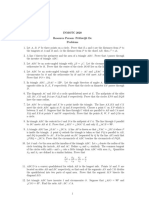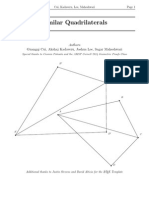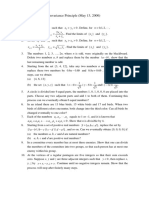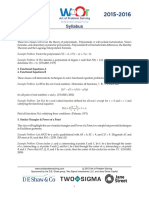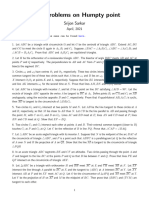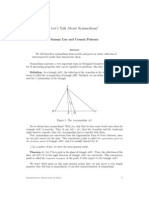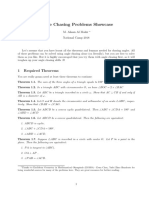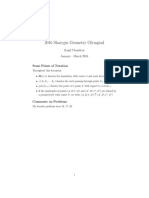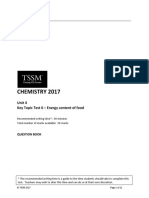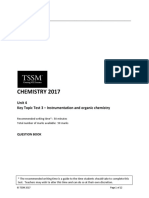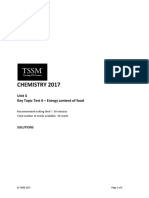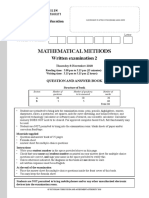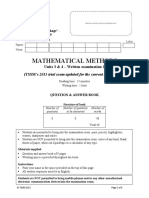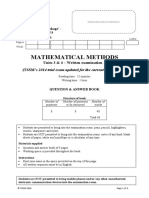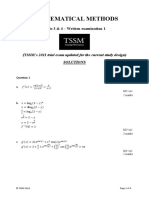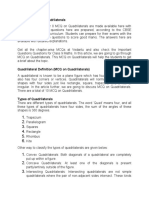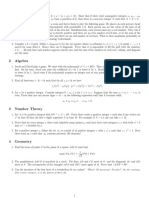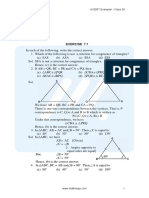2020 Winter Camp Configurations Victor Rong
A Few Configurations
Victor Rong
January 8, 2020
1 Around the Orthocenter
E0
C0 B0
E
O
0
F
F H
B D MA C
D0 A0
Let 4ABC have orthocenter H and circumcenter O. Denote the circumcircle of 4ABC by Γ. Let
D, E, and F be the feet of the altitudes and MA , MB , and MC be the midpoints. Let D0 , E 0 , and
F 0 be the second intersections of AH, BH, and CH respectively with Γ. Let A0 , B 0 , and C 0 be the
antipodes of A, B, and C with respect to Γ.
Fact 1.1. ∠BHC = π − ∠A.
Fact 1.2. Any one of A, B, C, H is the orthocenter of the triangle formed by the other three.
Fact 1.3. D0 is the reflection of H over BC.
Fact 1.4. D0 A0 k BC.
Fact 1.5. MA is the midpoint of HA0 .
Lemma 1 (Nine-Point Circle). D, E, F , MA , MB , MC lie on a common circle. Furthermore, the
midpoints of AH, BH, and CH lie on this circle. The center of this circle is the midpoint of OH.
Proof. From the previous facts, D is the midpoint of HD0 and MA is the midpoint of HA0 . Then
a homothety centered about H with scale factor 21 sends D0 to D and A0 to MA . Similarly, B 0 ,
E 0 , C 0 , and F 0 are sent to MB , E, MC , and F respectively. These points lie on Γ, so the mapped
points lie on the scaled-down circle, known as the nine-point circle. The rest of the lemma follows
easily from the homothety.
1 of 11
�2020 Winter Camp Configurations Victor Rong
PA
OA
E
F XA
O
H
QA C
B D MA
D0 A0
Let OA be the midpoint of AH. Let PA be the second intersection of A0 H and Γ. Let QA be the
intersection of EF and BC. Let XA be the foot of H on line AMA . XA (along with XB and XC
defined similarly) is known as an HM -point with respect to 4ABC.
Fact 1.6. E and F lie on the circle with diameter BC (and center MA ).
Fact 1.7. 4AEF ∼ 4ABC and 4BHF ∼ 4CHE.
Fact 1.8. OA OMA H and AOMA OA are parallelograms.
Fact 1.9. E and F lie on the circle with diameter AH (and center OA ).
Fact 1.10. PA and XA also lie on this circle.
Fact 1.11. The tangents to the circumcircle of 4AEF at points E and F intersect at MA .
Fact 1.12. 4PA EF ∼ 4PA CB.
Fact 1.13. A, PA , and QA are collinear.
Fact 1.14. XA lies on the circumcircle of 4BHC.
Fact 1.15. ∠CBXA = ∠BAXA and ∠BCXA = ∠CAXA .
XA B AB
Fact 1.16. XA lies on the A-Apollonius circle (in other words, XA C = AC ).
Fact 1.17. There are a lot of cyclic quads.
PA is particulary useful as the center of a spiral
√ similarity. Also, inverting works well with this
configuration. Inversion
√ about A with radius AH · AD, about MA with radius MA B, and about
H with radius HA · HD are all good options to try.
2 of 11
�2020 Winter Camp Configurations Victor Rong
Problems
Problem 1.1 (IberoAmerican 2011). Let ABC be an acute-angled triangle, with AC 6= BC and
let O be its circumcenter. Let P and Q be points such that BOAP and COP Q are parallelograms.
Show that Q is the orthocenter of ABC.
Problem 1.2 (USAMO 1990). An acute-angled triangle ABC is given in the plane. The circle
with diameter AB intersects altitude CC 0 and its extension at points M and N , and the circle
with diameter AC intersects altitude BB 0 and its extensions at P and Q. Prove that the points
M, N, P, Q lie on a common circle.
Problem 1.3 (JBMO 2019). Triangle ABC is such that AB < AC. The perpendicular bisector
of side BC intersects lines AB and AC at points P and Q, respectively. Let H be the orthocenter
of triangle ABC, and let M and N be the midpoints of segments BC and P Q, respectively. Prove
that lines HM and AN meet on the circumcircle of ABC.
Problem 1.4 (PAMO 2017). Let ABC be a triangle with H its orthocenter. The circle with
diameter AC cuts the circumcircle of triangle ABH at K. Prove that the point of intersection of
the lines CK and BH is the midpoint of the segment BH.
Problem 1.5 (USA TSTST 2012). In scalene triangle ABC, let the feet of the perpendiculars
from A to BC, B to CA, C to AB be A1 , B1 , C1 , respectively. Denote by A2 the intersection of
lines BC and B1 C1 . Define B2 and C2 analogously. Let D, E, F be the respective midpoints of
sides BC, CA, AB. Show that the perpendiculars from D to AA2 , E to BB2 and F to CC2 are
concurrent.
Problem 1.6 (ELMO 2017). Let ABC be a triangle with orthocenter H, and let M be the
midpoint of BC. Suppose that P and Q are distinct points on the circle with diameter AH,
different from A, such that M lies on line P Q. Prove that the orthocenter of 4AP Q lies on the
circumcircle of 4ABC.
Problem 1.7 (Iran TST 2019). Acute-angled triangle ABC has orthocenter H. The reflection
of the nine-point circle about AH intersects the circumcircle of 4ABC at points X and Y . Prove
that AH is the external bisector of ∠XHY .
Problem 1.8 (USA TST 2011). Acute triangle ABC is inscribed in circle ω. Let H and O denote
its orthocenter and circumcenter, respectively. Let M and N be the midpoints of sides AB and
AC, respectively. Rays M H and N H meet ω at P and Q, respectively. Lines M N and P Q meet
at R. Prove that OA ⊥ RA.
Problem 1.9 (Orthic axis). Let D, E, and F be the feet of the altitudes through A, B, and C
respectively in 4ABC. Let P , Q, and R be the intersections of EF with BC, F D with CA, and
DE with AB. Prove that P , Q, and R lie on a line perpendicular to the Euler line.
Problem 1.10 (Iran TST 2011). In acute triangle ABC, ∠B > ∠C. Let M be the midpoint of
BC. D and E are the feet of the altitudes from C and B respectively. K and L are the midpoints
of M E and M D respectively. If KL intersects the line through A parallel to BC at T , prove that
TA = TM.
Problem 1.11 (APMO 2012). Let ABC be an acute triangle. Denote by D the foot of the
perpendicular line drawn from the point A to the side BC, by M the midpoint of BC, and by H
the orthocenter of ABC. Let E be the point of intersection of the circumcircle Γ of the triangle
ABC and the half line M H, and F be the point of intersection (other than E) of the line ED and
the circle Γ. Prove that BF AB
CF = AC must hold.
3 of 11
�2020 Winter Camp Configurations Victor Rong
Problem 1.12 (ELMO 2018). Let ABC be a scalene triangle with orthocenter H and circum-
center O. Let P be the midpoint of AH and let T be on line BC with ∠T AO = 90◦ . Let X be the
foot of the altitude from O onto line P T . Prove that the midpoint of P X lies on the nine-point
circle of 4ABC.
Problem 1.13 (Iran MO 2017). Let ABC be an acute-angle triangle. Suppose that M be the
midpoint of BC and H be the orthocenter of ABC. Let E ≡ BH ∩ AC and F ≡ CH ∩ AB.
Suppose that X be a point on EF such that ∠XM H = ∠HAM and A, X are in the distinct side
of M H. Prove that AH bisects M X.
Problem 1.14. In triangle ABC, let A1 , B1 , C1 be the feet of the altitudes. Let H be the
orthocenter. Let M be the midpoint of BC. Let T be the intersection of B1 C1 and HM . The
tangents at B and C to the circumcircle of 4ABC intersect at P . Show that T, A1 , P are collinear.
Problem 1.15 (Iran MO 2013). In a triangle ABC with circumcircle Γ, suppose that the A-
altitude intersects Γ at point D. The altitude of B and C cut AC and AB at E and F respectively.
Let H be the orthocenter and T be the midpoint of AH. The line through T parallel to EF
intersects AB and AC at X and Y respectively. Prove that ∠XDF = ∠Y DE.
Problem 1.16 (ISL 2008). In an acute triangle ABC segments BE and CF are altitudes. Two
circles passing through the point A and F and tangent to the line BC at the points P and Q so
that B lies between C and Q. Prove that lines P E and QF intersect on the circumcircle of triangle
AEF .
Problem 1.17 (ISL 2017). Let O be the circumcenter of an acute triangle ABC. Line OA
intersects the altitudes of ABC through B and C at P and Q, respectively. The altitudes meet at
H. Prove that the circumcenter of triangle P QH lies on a median of triangle ABC.
Problem 1.18 (ISL 2016). Let ABCD be a convex quadrilateral with ∠ABC = ∠ADC < 90◦ .
The internal angle bisectors of ∠ABC and ∠ADC meet AC at E and F respectively, and meet each
other at point P . Let M be the midpoint of AC and let ω be the circumcircle of triangle BP D.
Segments BM and DM intersect ω again at X and Y respectively. Denote by Q the intersection
point of lines XE and Y F . Prove that P Q ⊥ AC.
Problem 1.19 (RMM 2018). Fix a circle Γ, a line ` to tangent Γ, and another circle Ω disjoint
from ` such that Γ and Ω lie on opposite sides of `. The tangents to Γ from a variable point X on
Ω meet ` at Y and Z. Prove that, as X varies over Ω, the circumcircle of XY Z is tangent to two
fixed circles.
4 of 11
�2020 Winter Camp Configurations Victor Rong
2 Incenters and Excenters
A
B C
IA
Let 4ABC have incenter I and circumcircle Γ. Denote the excenters as IA , IB , and IC . Let LA
_
be the midpoint of arc BC not containing A.
π+∠A
Fact 2.1. ∠BIC = 2 .
Lemma 2 (Fact 5). LA lies on the angle bisector of ∠A. Furthermore, BICIA is a cyclic quadri-
lateral and LA is the center of its circumcircle.
Proof. Since LA is the midpoint of the arc BC, ∠CALA = ∠LA AB. So LA lies on the bisector of
∠A. We have
∠B π − ∠B π
∠IBIA = + = .
2 2 2
π
Similarly, ∠ICIA = 2 . So B and C lie on a circle with diameter IIA .
From cyclic quadrilateral ABLC we have ∠BLA I = ∠C and from cyclic quadrilateral BICIA we
have ∠BIA I = ∠C
2 . Thus LA must be the center of the circle with diameter IIA .
Corollary 3. For any 4XY Z, let W be the intersection of the perpendicular bisector of Y Z
with the angle bisector of ∠X. Then W lies on the circumcircle of 4XY Z.
5 of 11
�2020 Winter Camp Configurations Victor Rong
Lemma 4 (Euler’s Theorem). OI 2 = R(R − 2r) where R is the circumradius of 4ABC and r is
the inradius of 4ABC.
Proof. We can compute the distance OI by considering the power of I with respect to Γ:
OI 2 − R2 = P ow(I, Γ) = −IA · ILA = −IA · LA C.
We used Lemma 2 in the above line. Let F be the tangency point of the incircle to AB and let M
be the midpoint of LA C. Note that 4IAD ∼ 4LA OM . Thus
AI OLA
=
ID LA M
=⇒ IA · LA M = ID · OLA
=⇒ IA · LA C = 2ID · OLA
= 2rR.
Thus,
OI 2 = R(R − 2r).
IB
IC
Y
Z
O
I
B C
X
LA
IA
Let X, Y , and Z be the intersections of the angle bisectors with the respective sides.
6 of 11
�2020 Winter Camp Configurations Victor Rong
Fact 2.2. I is the orthocenter of 4LA LB LC (where LB and LC are defined similarly).
Fact 2.3. 4LA XC ∼ 4LA CA and LA X · LA A = LI 2 .
Fact 2.4. 4ABC is the orthic triangle of 4IA IB IC . I is the orthocenter and Γ is the nine-point
circle.
_
Fact 2.5. The midpoint of arc BC containing A in Γ is the midpoint of IB IC .
Fact 2.6. The radical axis of the B-excircle and C-excircle is the line through the midpoint of BC
parallel to AI. The radical axis of the incircle and the A-excircle is the line through the midpoint
of BC perpendicular to AI.
Fact 2.7. The intouch triangle, the excentral triangle, and 4LA LB LC (where LB and LC are
defined similarly) are homothetic to each other.
Fact 2.8. The Euler line of the excentral triangle is OI. The Euler line of the intouch triangle is
also OI.
Fact 2.9. The circumcenter of 4IIB IC lies on line OIA .
Fact 2.10. Lines IB IC , Y Z, and BC concur at the foot of the A-external angle bisector.
Fact 2.11. Y Z ⊥ OIA .
Problems
Problem 2.1. Let ABCD be a cyclic quadrilateral. Let IA , IB , IC , and ID be the incenters of
4BCD, 4CDA, 4DAB, and 4ABC respectively. Show that IA IB IC ID is a rectangle.
Problem 2.2. Let ABC be an acute triangle with ∠A = 60◦ . Show that IH = IO where I, H,
and O are the incenter, orthocenter, and circumcenter respectively.
Problem 2.3 (Hong Kong TST 2020). Let ∆ABC be an acute triangle with incenter I and
orthocenter H. AI meets the circumcircle of ∆ABC again at M . Suppose the length IM is
exactly the circumradius of ∆ABC. Show that AH ≥ AI.
Problem 2.4 (ELMOSL 2013). Let ABC be a triangle with incenter I. Let U , V and W be the
intersections of the angle bisectors of angles A, B, and C with the incircle, so that V lies between
B and I, and similarly with U and W . Let X, Y , and Z be the points of tangency of the incircle of
triangle ABC with BC, AC, and AB, respectively. Let triangle U V W be the David Yang triangle
of ABC and let XY Z be the Scott Wu triangle of ABC. Prove that the David Yang and Scott
Wu triangles of a triangle are congruent if and only if ABC is equilateral.
Problem 2.5 (USAJMO 2016). The isosceles triangle 4ABC, with AB = AC, is inscribed in
_
the circle ω. Let P be a variable point on the arc BC that does not contain A, and let IB and
IC denote the incenters of triangles 4ABP and 4ACP , respectively. Prove that as P varies, the
circumcircle of triangle 4P IB IC passes through a fixed point.
Problem 2.6 (USAJMO 2014). Let ABC be a triangle with incenter I, incircle γ and circumcircle
Γ. Let M, N, P be the midpoints of sides BC, CA, AB and let E, F be the tangency points of γ
with CA and AB, respectively. Let U, V be the intersections of line EF with line M N and line
M P , respectively, and let X be the midpoint of arc BAC of Γ.
(a) Prove that I lies on ray CV .
(b) Prove that line XI bisects U V .
7 of 11
�2020 Winter Camp Configurations Victor Rong
Problem 2.7. Let 4ABC have incenter I and orthocenter H. Let RA be the radical center of
the incircle, B-excircle, and C-excircle. Define RB and RC similarly. Prove that the circumcenter
of 4RA RB RC is the midpoint of HI.
Problem 2.8 (ISL 2002). The incircle Ω of the acute-angled triangle ABC is tangent to its side
BC at a point K. Let AD be an altitude of triangle ABC, and let M be the midpoint of the
segment AD. If N is the common point of the circle Ω and the line KM (distinct from K), then
prove that the incircle Ω and the circumcircle of triangle BCN are tangent to each other at the
point N .
Problem 2.9 (USAMO 2017). Let ABC be a scalene triangle with circumcircle Ω and incenter
I. Ray AI meets BC at D and meets Ω again at M ; the circle with diameter DM cuts Ω again at
K. Lines M K and BC meet at S, and N is the midpoint of IS. The circumcircles of 4KID and
4M AN intersect at points L1 and L2 . Prove that Ω passes through the midpoint of either IL1 or
IL2 .
Problem 2.10 (USAMO 2016). Let 4ABC be an acute triangle, and let IB , IC , and O denote
its B-excenter, C-excenter, and circumcenter, respectively. Points E and Y are selected on AC
such that ∠ABY = ∠CBY and BE ⊥ AC. Similarly, points F and Z are selected on AB such
←−→ ←−→
that ∠ACZ = ∠BCZ and CF ⊥ AB. Lines IB F and IC E meet at P . Prove that P O and Y Z are
perpendicular.
Problem 2.11 (ISL 2016). Let I be the incentre of a non-equilateral triangle ABC, IA be the
A-excentre, IA 0 be the reflection of I in BC, and l be the reflection of line AI 0 in AI. Define
A A A
0 and line l analogously. Let P be the intersection point of l and l .
points IB , IB B A B
(a) Prove that P lies on line OI where O is the circumcentre of triangle ABC.
(b) Let one of the tangents from P to the incircle of triangle ABC meet the circumcircle at points
X and Y . Show that ∠XIY = 120◦ .
Problem 2.12 (Serbia MO 2017). Let k be the circumcircle of 4ABC and let ka be A-excircle.
Let the two external tangents of k and ka cut BC in at points P and Q. Prove that ]P AB = ]CAQ.
8 of 11
�2020 Winter Camp Configurations Victor Rong
3 Isogonal Conjugates
A
Y2
Z2
P∗
Y1
Z1
B X2 X1 C
Lemma 5 (Pedal Triangles of Isogonal Conjugates). Let P1 and P2 be points in the plane of
4ABC. Let 4X1 Y1 Z1 and 4X2 Y2 Z2 be the pedal triangles of P1 and P2 respectively. Then P1
and P2 are isogonal conjugates iff 4X1 Y1 Z1 and 4X2 Y2 Z2 have the same circumcircle.
Proof. Let P be a point in the plane of 4ABC with pedal triangle 4X1 Y1 Z1 . The circumcircle
of 4X1 Y1 Z1 intersects BC, CA, and AB again at X2 , Y2 , and Z2 respectively. Let O be the
circumcenter of 4X1 Y1 Z1 .
Define P ∗ to be the reflection of P across O. Since O is on the perpendicular bisector of X1 X2 and
P is on the line through X1 perpendicular to BC, then P ∗ is on the line through X2 perpendicular
to BC. Similarly, P ∗ Y2 ⊥ CA and P ∗ Z2 ⊥ AB.
Since Y1 Z1 Z2 Y2 is a cyclic quadrilateral, 4AY1 Z1 ∼ 4AZ2 Y2 . P and P ∗ are defined similarly with
respect to these two triangles, so we can further state that AY1 Z1 P ∼ AZ2 Y2 P ∗ . In particular,
∠P AC = ∠P AY1 = ∠P ∗ AZ2 = ∠P ∗ AB.
Similarly, ∠P CB = ∠P ∗ CA and ∠P BC = ∠P ∗ BA. Thus, P ∗ is the isogonal conjugate of P .
This shows one direction of Lemma 5: that if the pedal triangles share a circumcircle, then the
points are isogonal conjugates. The definition of the isogonal conjugate of a point implies that
there is either none or exactly one. Since we have shown how to construct this isogonal conjugate
for any point P , the other direction follows.
9 of 11
�2020 Winter Camp Configurations Victor Rong
D
V
A
U P∗
S
B
T
Let P be a point in the plane of quadrilateral ABCD. The isogonal conjugate of P with respect
to ABCD is the point P ∗ such that
∠DAP = ∠P ∗ AB, ∠ABP = ∠P ∗ BC, ∠BCP = ∠P ∗ CD, and ∠CDP = ∠P ∗ DA.
Lemma 6 (Isogonal Conjugates in Quadrilaterals). The isogonal conjugate of P with respect to
ABCD exists iff ∠AP B + ∠CP D = π.
Proof. Let E be the intersection of AD and BC. Let S, T , U , and V be the feet of P to AB, BC,
CD, and DA respectively. Let P1 be the isogonal conjugate of P with respect to 4EAB and P2
be the isogonal conjugate of P with respect to 4ECD.
Observe that the isogonal conjugate of P with respect to ABCD exists iff P1 ≡ P2 . It is not hard
to see that this occurs iff the circumcircle of the pedal triangle of P1 with respect to 4EAB is the
same as the circumcircle of the pedal triangle of P2 with respect to 4ECD. By Lemma 5, this is
equivalent to S, T , U , V concyclic.
It remains to show that S, T , U , V concyclic iff ∠AP B + ∠CP D = π.
∠AP B + ∠CP D = ∠AP S + ∠SP B + ∠CP U + ∠U P D
= ∠AV S + ∠ST B + ∠CT U + ∠U V D
= (π − ∠ST U ) + (π − ∠U V S)
= 2π − (∠ST U + ∠U V S).
10 of 11
�2020 Winter Camp Configurations Victor Rong
Problems
Problem 3.1. Prove that the circumcenter O and the orthocenter H are isogonal conjugates.
What is the circumcircle of their pedal triangles?
Problem 3.2. Let P and Q be isogonal conjugates with respect to a triangle ABC. Show that
d(P, AB) · d(Q, AB) = d(P, AC) · d(Q, AC).
Problem 3.3. Let P be a point in the interior of 4ABC. Points D, E, and F are the reflections
of P over BC, CA, and AB respectively. Show that the circumcenter of 4DEF is the isogonal
conjugate of P with respect to 4ABC.
Problem 3.4 (Bulgaria 2011). Point O is inside 4ABC. The feet of perpendicular from O to
BC, CA, AB are D, E, F . Perpendiculars from A and B respectively to EF and F D meet at P .
Let H be the foot of perpendicular from P to AB. Prove that D, E, F, H are concyclic.
Problem 3.5 (USAMO 2011). Let P be a given point inside quadrilateral ABCD. Points Q1
and Q2 are located within ABCD such that
∠Q1 BC = ∠ABP, ∠Q1 CB = ∠DCP, ∠Q2 AD = ∠BAP, ∠Q2 DA = ∠CDP.
Prove that Q1 Q2 k AB if and only if Q1 Q2 k CD.
Problem 3.6 (USA TST 2010). In triangle ABC, let P and Q be two interior points such that
∠ABP = ∠QBC and ∠ACP = ∠QCB. Point D lies on segment BC. Prove that ∠AP B +
∠DP C = 180◦ if and only if ∠AQC + ∠DQB = 180◦ .
Problem 3.7 (ISL 2008). There is given a convex quadrilateral ABCD. Prove that there exists
a point P inside the quadrilateral such that
∠P AB + ∠P DC = ∠P BC + ∠P AD = ∠P CD + ∠P BA = ∠P DA + ∠P CB = 90◦
if and only if the diagonals AC and BD are perpendicular.
Problem 3.8 (USAJMO 2015). Let ABCD be a quadrilateral. Prove that there exists a point
X on segment BD such that ∠BAC = ∠XAD and ∠BCA = ∠XCD if and only if there exists a
point Y on segment AC such that ∠CBD = ∠Y BA and ∠CDB = ∠Y DA. (The original problem
had ABCD cyclic.)
Problem 3.9 (IMO 2018). A convex quadrilateral ABCD satisfies AB · CD = BC · DA. Point
X lies inside ABCD so that
∠XAB = ∠XCD and ∠XBC = ∠XDA.
Prove that ∠BXA + ∠DXC = 180◦ .
Problem 3.10 (ELMOSL 2014). We are given triangles ABC and DEF such that D ∈ BC, E ∈
CA, F ∈ AB, AD ⊥ EF, BE ⊥ F D, CF ⊥ DE. Let the circumcenter of DEF be O, and
let the circumcircle of DEF intersect BC, CA, AB again at R, S, T respectively. Prove that the
perpendiculars to BC, CA, AB through D, E, F respectively intersect at a point X, and the lines
AR, BS, CT intersect at a point Y , such that O, X, Y are collinear.
Problem 3.11 (USA TST 2015). Let ABC be a non-equilateral triangle and let Ma , Mb , Mc be
the midpoints of the sides BC, CA, AB, respectively. Let S be a point lying on the Euler line.
Denote by X, Y , Z the second intersections of Ma S, Mb S, Mc S with the nine-point circle. Prove
that AX, BY , CZ are concurrent.
11 of 11


























